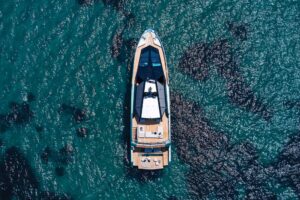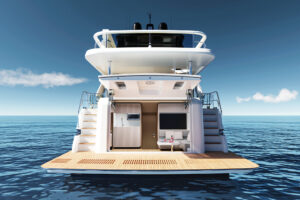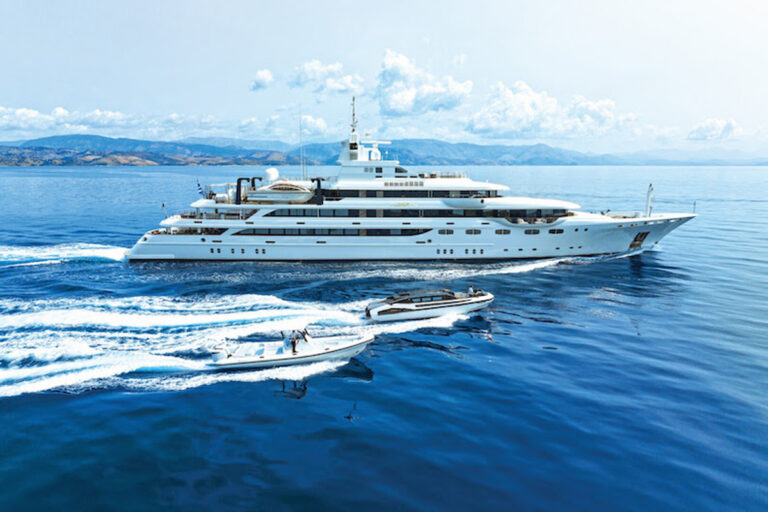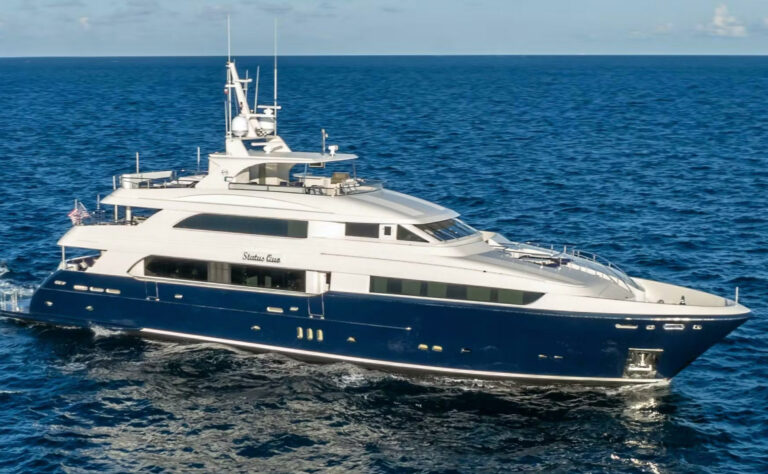
Riva 68
There’s nothing bashful about Riva, and no owner of one of Italy’s most iconic products is ever going to be lacking in a certain quality. But even so, the idea of the company naming its latest poetic incarnation of the boating ideal after what the average Freudian analyst would advise keeping under wraps does strike this Englishman’s ear as, well, slightly bodacious.
But then this Riva 68 Ego is one bodacious boat. And it was fitting that my sea trial should debark from Porto Carlo Riva in Rapallo, Italy. This is the marina that was created by Carlo Riva when he retired from Riva after supervising its transition from a builder of the classic wooden Rivas into one of the early users of fiberglass. That Carlo Riva himself came down to see us off put a monogrammed stamp on the occasion.
The 68 Ego certainly looks the part of the perfect accessory for a robust psyche. Here is a sports yacht like you have never seen before, a style you cannot ignore, with its black hull and bronze-hued superstructure. In fact, if outside style were the only criteria on which to judge a new yacht, then the Ego would win hands down. Not only is the color scheme stunning (and there is a whole range of alternatives to choose from), but the exterior styling leaves you in no doubt that this design has been produced both to impress and to perform.
Personally, I would stick to the black and bronze color scheme, perfect unless you’re the rare owner who wants his yacht to pass unnoticed in the marina. Part of the Riva ethos is that you go yachting in style and the Ego certainly achieves this.
The Ego also oozes quality. It may be small things like the teak of the handrails or the way that the grating on the passerelle has curved cross strips. Wherever you look, you notice the attention to detail that is the hallmark of the Riva style; and inevitably you end up thinking: “I bet that costs money. Which is another reason to own an Ego-it buffs your ego in the eyes of the beholder.
Riva has brought in the design team of Micheli and Beretta of Italiana Design to work on this new 68. They have opted for a very modern interior, which is in keeping with the current Riva style. Interestingly, however, they have introduced furniture that looks as though it was produced in the 1960s. Retro is all the rage in design these days, and the sharp-edged, teak-veneered furniture on display here most resembles the Scandinavian style that was so popular during the Swinging Sixties. Does it work on a yacht of this size and personality? There is no getting away from the luxury of the white-leather settees, though for comfort the backs could be higher-which is something I remember being a problem with modern furniture back in the days of Austin Powers, too.
Down below the more traditional Riva style is much stronger, beginning with the black walnut paneling. A wood with a strong, straight grain, this contrasts well with the off-white fabrics, the metallic silver panels and the silver Venetian blinds. Glass and stainless steel tables extend the ultramodern look.
The galley has what looks like a huge fridge with a leather-paneled door. Open the door to this vault, however, and you find another door, this to a much smaller fridge inside, in addition to a large amount of stowage space-some of it dedicated to the Richard Ginori crockery and Riva’s own silver-plated cutlery. The galley also includes a full stove and dishwasher for easy living on board.
The Ego is a three-cabin yacht: The master is in the bow, and a twin and a double are in the aft section with the saloon, separated by the dining area and galley. Optional layouts show the dining area converted into a fourth cabin or the master cabin moved aft, which then converts the dining area into the master bathroom. In fact, there are a lot of options here-except for the crew, whose twin-bunk cabin aft will probably not be in great demand in the U.S. market.
While I may have harbored a doubt or two about what that hard-edged Swedish interior would do for my more delicate sensibility (and body parts), I have no such doubts about the handling of this sports yacht. In this category, performance is king, and this yacht is a joy to drive, responding like a good sports car to the driver’s commands and giving a ride in difficult sea conditions that will be the envy of competitors.
The top speed is up towards the 38-knot mark, which has its own excitement, but what makes the Ego stand out is the way that you feel: fully in control and taking supreme pleasure in driving. This hull was the prototype straight out of the factory and the ride does need to be fine-tuned by using the tabs when heading into the waves, but by keeping the bow down in this way the ride leveled out and was comfortable even in waves that were reaching five feet in height. While not the conditions you normally associate with sunny Portofino, these certainly made for good boat-testing weather-and the Ego came through with flying colors.
The helm is well laid out as far as the controls are concerned. An angled white-leather wheel replaces the usual vertical one, which contributes to the feeling of responsiveness, complemented in turn by well-placed throttles. The electronic displays for the MAN diesels are easy to read although a clear plastic cover over the navigation electronics does not seem to have a purpose except to introduce reflections. Visibility from the helm is excellent, except for the wide side pillars in the corners. With the double sun roof open, all is sublime-you get a really sporting feel driving this yacht.
Down below, the two 1,550 hp MAN diesels take up a lot of the available space in the engine compartment, making access to some areas rather difficult. These engines drive forward to ZF V-drive gearboxes; these are quite noisy and can intrude on the serenity of the aft cabins if you want to use them at sea.
The hull of the Ego is a conventional moderate-V with a 12-degree deadrise at the transom and propellers recessed into semi-tunnels to reduce the draft. The underwater hull extends right aft under the narrow swim platform and even the tabs are tidily recessed into the hull for a clean finish.
Finishing touches come up to and often exceed the already very high Riva standard, including the hand-blown Murano glass washbasins and the use of exotic woods. I love the mini-Bimini that is incorporated over the head of the forward sun bed, so that you can command shade at the touch of a button. It is these kinds of luxurious, personal touches that make Riva unique-a name synonymous with quality unto itself. It was indicative of the company’s tenacious hold on quality control that our test yacht, straight out of the building yard and getting its first public airing, had Norberto Ferretti on board with his designers. I am quite sure we shall see changes and enhancements that will make this superb yacht even more of an ego booster than it already is.
Contact: Riva S.p.A., (011) 39 035910202; www.riva-yacht.com.









